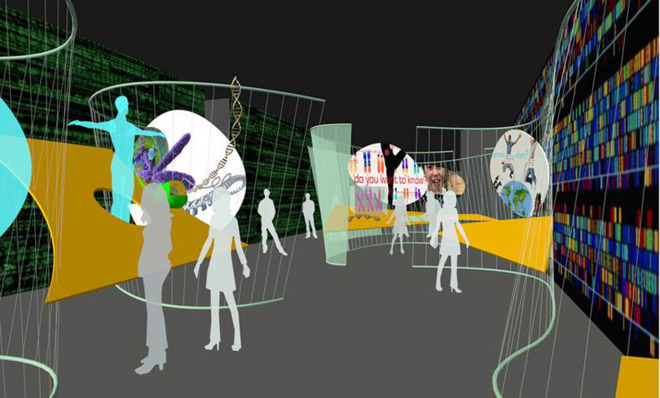Why our molecular makeup can't explain who we are
Molecular behavior and human behavior are two completely different things


Can the behavior of molecules and cells explain human behavior? The question of how the social becomes biological is, in one sense, about linking social effects with biological causes. Those causes are now more accessible than ever, thanks to new tools that researchers use to get under the hood in biology. But are we really connecting cause with effect? A close look at this research reveals a giant gap in our understanding of the relationship between molecular and human behavior. It's a gap that we will rarely bridge.
At first glance, you would think we have ample reason to be optimistic. For much of the history of genetics, scientists couldn't study our genes directly. Now, in the aftermath of the Human Genome Project, that's no longer the case. We have the ability to directly analyze all human genes. We have a rapidly expanding catalog of genes and their molecular functions. And nearly every week, new studies report genetic differences between people that are correlated with differences in particular traits, including social ones such as personality, political orientation, and educational attainment.
But when you dig into the results, you're quickly confronted with a major gap in our understanding. Even if you take the study results as given (which you shouldn't), there is a lot left to explain. We may know the identity of a relevant gene, and we may even know how that gene functions inside the cell. But we usually have absolutely no idea how that function influences the behavior of a complete, living person — we don't have an unbroken chain of cause and effect linking molecular behavior to human behavior. We don't even come close; we're not explaining the biological basis of something like educational attainment by merely listing associated genes like LRRN2, MDM4, and PIK3C2.
The Week
Escape your echo chamber. Get the facts behind the news, plus analysis from multiple perspectives.

Sign up for The Week's Free Newsletters
From our morning news briefing to a weekly Good News Newsletter, get the best of The Week delivered directly to your inbox.
From our morning news briefing to a weekly Good News Newsletter, get the best of The Week delivered directly to your inbox.
This problem isn't limited to genetic studies of social traits in humans; it's faced by all biologists interested in the molecular underpinnings of life, including those who study laboratory animals under highly controlled conditions. We have amassed a tremendous inventory of molecular parts, but in most cases, we're unable to reason from molecules out to the traits of an entire organism. It's a problem that we're unlikely to solve. Aside from some exceptions — such as the molecular basis of blond hair in some Europeans — there is no reason to think that we'll ever explain biology from molecules alone.
Why not? One way to see the problem is to compare biology with a science where we can explain large-scale behavior in terms of molecules: physics. Physical scientists can explain the properties of solids, liquids, and gases by writing down an equation that describes the quantum behavior of individual atoms. That equation then directly connects the function of the whole with the properties of its parts — the overall qualities of, say, a semi-conductor are explained by the features of trillions of individual silicon atoms. The reason biologists can't do this is obvious: Biology is too complex. Living things are made up of too many different kinds of parts, organized in fantastically complex ways, all responding to each other and to the environment. And social behaviors in particular tend to involve many different parts. The gap between a molecular cause and a behavioral effect is too great. Outside of the most limited cases, we'll never be able to span it with a complete chain of deductive reasoning.
In other words, we shouldn't expect a biological explanation of social traits to look like physics. We have to be more pragmatic in the kinds of explanations we look for. Sometimes the explanation will be an exercise in statistics, as in "genes explain 66 percent of the variation in reading ability." In other cases, particularly pathological ones, a molecular explanation is more useful — knowing that a defective histidine decarboxylase enzyme causes Tourette syndrome, even if we can't say why, opens up new options for treatment. Useful biological explanations will often bypass molecules and work instead on a higher level, such as the connection between alcohol abuse and the function of different regions of the brain. As the philosopher Philip Kitcher once put it, sometimes "it's irrelevant whether the genes are made of nucleic acid or of Swiss cheese."
Regardless of what kinds of biological explanations we resort to, we have to recognize that any answer to the question of how the social becomes biological will be a partial one. And that can be dangerous. When we're unsatisfied with incomplete explanations, we may look to fill the gaps with facile answers supported by weak or no evidence. Genetic studies of social traits grab headlines, but they can mislead us into thinking that scientists are explaining more than is really the case. It's hard to see how understanding the detailed workings of phosphatidylinositol-4-phosphate 3-kinase will ever tell us much about why some people succeed more than others at school, or how studying N(alpha)-acetyltransferase 15 will be of much help in understanding why people adopt a certain political orientation. How and why the social becomes biological is an important and fascinating question, but we shouldn't expect genes to always be a useful answer.
A free daily email with the biggest news stories of the day – and the best features from TheWeek.com
Pacific Standard grapples with the nation's biggest issues by illuminating why we do what we do. For more on the science of society, sign up for its weekly email update or subscribe to its bimonthly print magazine.
More from Pacific Standard...
-
 Which side is JD Vance taking in MAGA’s infighting?
Which side is JD Vance taking in MAGA’s infighting?Today’s Big Question GOP insiders are battling over antisemitism with an eye on 2028
-
 Campus security is in the public eye again after the Brown shooting
Campus security is in the public eye again after the Brown shootingTalking Points Questions surround a federal law called the Clery Act
-
 9 new cookbooks begging to be put to good winter use
9 new cookbooks begging to be put to good winter usethe week recommends Booze-free drinks, the magic versatility of breadcrumbs and Japanese one-pot cooking